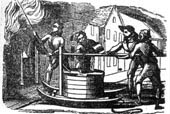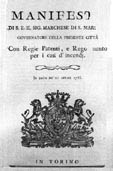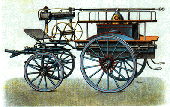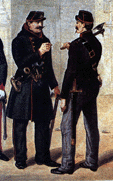-
|
- THE
FIREMEN' S HISTORICAL MUSEUM
|
-
|


|
-
Until
a few years ago, in accordance with the idea about the definition
of historical and cultural assets, real historical significance
could be given only to religious buildings, to artistical works,
to a castle, or to a monument. Consequently it was impossible to
give the right importance to all other buildings and to their restoration
works. Unfortunately many things were lost.
The same fate happened to all the machinery, and the equipment concerning
the Firemen's long tradition. We wanted to challenge the past and
the oblivion through the idea of a museum able to give evidence
of the Firemen history of the Italian.
This challenge was the result of the determination and the work
of the Firemen's Historical Association, of the public authorities,
and of public citizens who made possible to collect, to restore
and to treasure a property of such great importance.
Who can forget the Roman Forces, the first example of civil defence
against fires in the ancient world? Or the glorious history of the
"Guardie a Fuoco" already active in the XIV century in Florence?
Or the history of the artisans that had to defend their city, Turin,
beginning from 1442?
These are only a few examples that have contributed to the consolidation
of the relationship with the population of every single city. Today
this heritage has enabled us to create an extraordinary exhibition.
This will be the first museum in Italy that holds in great esteem
the history of Firemen.
It will show a lot of things: the machinery and the equipment, from
the largest to the smallest, and the documents that are part of
the history from the seventeeenth century until today.
|
-
|
- The Exhibition Areas
|
-
|

|
- The big collection
of the museum (about 50 motor vehicles, the equipment and a lot of
photographs and documents) will be collected in the two pre-existent
floors.
However it is not a pure exhibition of photos and material. The visitors
(students, professional people, experts and fans) can interact in
order to share the different moments and the historical events. Also
young people, generally schoolchildren, can interact by operating
the machinery.
Every area will also be accessible for disabled people. In addition
all the descriptions will be written in different languages, in order
to underline the European vocation of the museum.
|
-
|
| |
- The Collection of Photographs
and Documents
|
-
|

-
-
|
- The large number
of photos and documents has enabled us to organize interesting routes
that show the historical evolution of the Association.
There are:
-about 4000 photograms and 2000 photos concerning the Second World
War.
-about 10000 photograms concerning the years before and after the
Second World War. -photographic equipment from the first years of
the century.
-documents already catalogued that represent important events.
-other documents that need to be catalogued.
|
-
|
These
documents will be classified as follows:
· handwritten documents beginning from the eighteenth century.
· reports concerning fire interventions in the 1920s.
· reports concerning the interventions during the war.
· documents about motor vehicles, equipment, the staff and the typology
of intervention, from the second half of the eighteenth century.
· account-books beginning from the end of the previous century.
- staff files from the nineteenth century.
To complete the exhibition there will be some areas where the visitors
have the opportunity to obtain precise information about some of the characteristics
of the historical period and of a particular intervention.
An example could be: the photographs of Turin during the second World
War show the dramatic reality of the years, the problems due to the war,
like the starvation, the cold, the new fears, the eavacuated people....etc....
People were not used to these problems, but they had to think about that.
|




